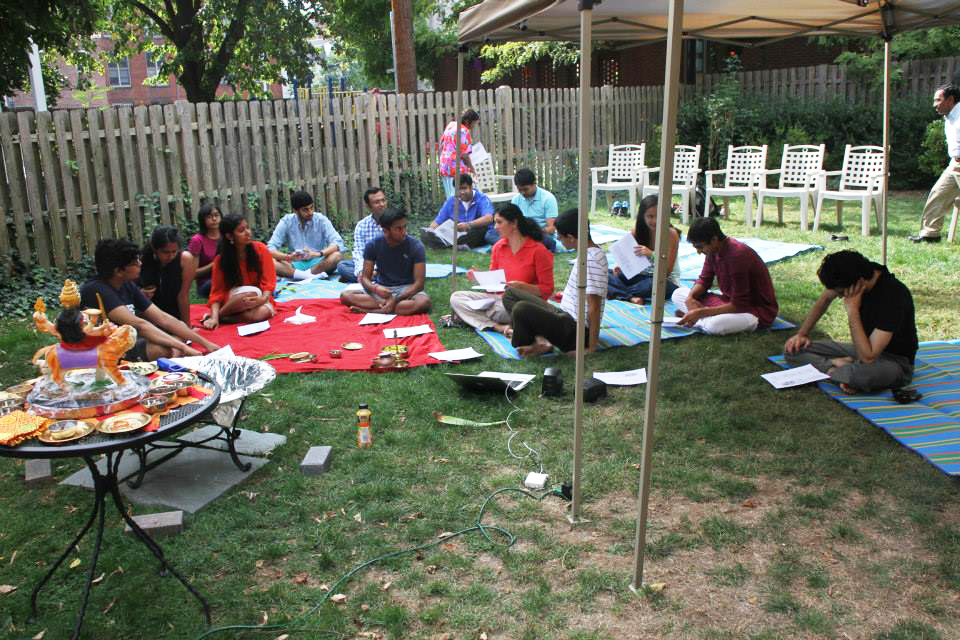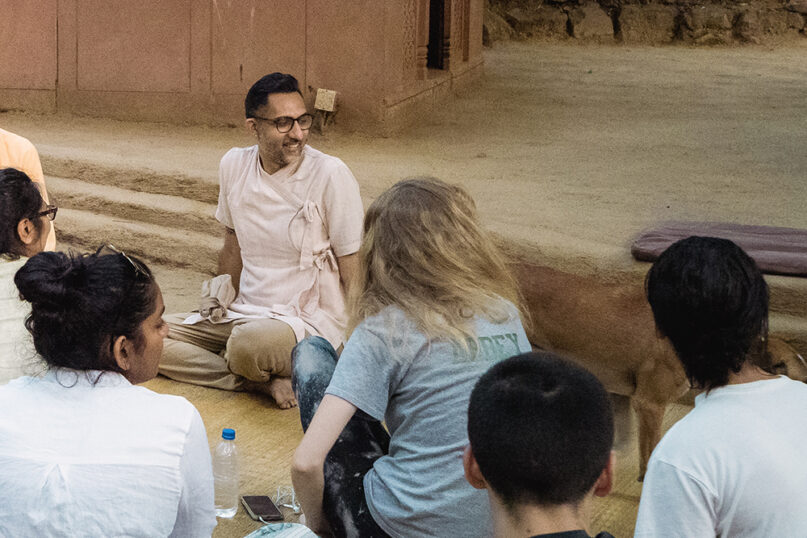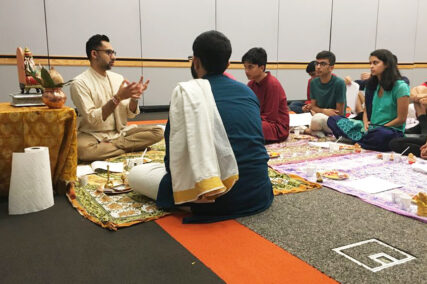(RNS) — When Vineet Chander accepted his job as the Hindu chaplain at Princeton University in 2008, his Hindu community was baffled by his profession.
“It was incomprehensible to them,” said Chander. “I’d have people look at me like, what do you do? This is a full-time job?”
Their puzzlement was understandable: Chander, a former prosecutor, was not just the only full-time Hindu chaplain at any place of higher learning at the time; he was the first Hindu in the United States ever to fill the role. In part, Chander said, that’s because there have only been “notable” numbers of Hindu students on campus since the 1970s.
Another factor is the title of chaplain itself. While Hinduism readily recognizes the idea of spiritual caregiving, chaplaincy traditionally has been associated with Christian ministers and is not easily translated into a Hindu framework.
Hindus traditionally rely on gurus for spiritual guidance, but the rigorous training — often requiring 12 years of study — and the relatively few Hindus in the U.S., where they make up about 1% of the population, means that there are few gurus with the required qualifications.
“The basic challenge is that Hindus don’t often understand what chaplaincy is, and non-Hindus don’t really have a familiarity with Hinduism,” said Asha Shipman, director of Hindu life at Yale University.
In addition, Shipman said, many universities hire chaplains through outside institutions like mosques, synagogues or church councils. “Hindus don’t have any organization they can turn to,” said Shipman.
Shipman has set to work to change that. Last year she and several colleagues founded the North American Hindu Chaplains Association, which will hold its second annual conference this weekend, with about 50 attendees.
The conference, which will meet virtually, will include keynotes on caring for caregivers from a Dharmic perspective and queerness in Hinduism. It will also feature “possibility sessions” that allow participants to share hopes and suggestions for the field moving forward.
“This is a nascent field, and in many ways it feels like we’re giving birth to it,” said Shipman. “I see such a great need to expand the number of Hindu chaplains, not just in higher education, but health care and other domains.”
Shipman hopes that NAHCA will grow to provide the theological training in Hinduism and Dharmic studies that is currently missing at American seminaries and universities. The organization also aims to develop a process for chaplains who want to become board certified.
RELATED: Conference fuels growing US debate over Hindu nationalism
In the meantime, Hindu chaplaincy is evolving according to its local practitioners and those they serve. At Princeton, Chander hosts speakers, conferences and ritual worship and also meets one on one with his students for spiritual care. Chander said when he initially tried to hold office hours, which are typical of other chaplains, it “totally flopped.”
“Students had no framework or structure for what it meant to go talk to a chaplain, least of all a Hindu chaplain,” said Chander. “The notion of that was so new and foreign, so I had to switch gears.” Chander started meeting with students for coffee, a tactic he found much more effective.
At Yale, Shipman said that unlike some of her chaplain colleagues, she doesn’t lead a congregation — instead, she offers a range of spiritual opportunities that include mentoring, teaching students how to lead worship services and hosting celebrations for festivals such as Diwali.
The field of chaplaincy of all kinds has been on the rise in recent years. A 2019 national poll found that 21% of Americans reported having contact with a chaplain in the previous two years, and chaplains are being found in an increasing variety of spaces: airports, farms and even corporate settings. And as institutional religion in the U.S. declines, the transformed religious landscape is changing not just where chaplains work — but how.
“There’s a way in which the growth of Hindu chaplaincy speaks to increasing development and evolution of chaplaincy writ large, where it’s becoming a lot less Christian-centric, and there’s a recognition of a real opportunity to have authentic multi-faith approaches to chaplaincy,” said Chander.
The pandemic has accelerated this trend and opened more opportunity for Hindu spiritual caregivers, Shipman points out: the last year and a half, she said, has brought an increased awareness of Hindu meditative and breathing practices.
Shama Mehta is a hospital chaplain of the Hindu faith who was board certified in 2016. “When I started chaplaincy, there were not that many health care chaplains I could reach out to that were of the Hindu faith,” said Mehta.

Asha Shipman, director of Hindu life at Yale University, with her students before starting the Navratri Homa. Photo courtesy of Shipman
Mehta provides support and care to anyone at the hospital who needs it, including staff. “The more I do chaplaincy, the better Hindu I become,” said Mehta. “It pushes me to look at things from such a broad perspective and to find ways to continue to serve others while being nurtured by my own faith, because that’s what allows me to be there for other people.”
On campus, the number of younger Hindus who see a need for spiritual guidance has grown — according to Chander, there are now five full-time Hindu chaplains in higher education, a dozen or so part-time Hindu chaplains and a much larger number of volunteers and affiliates.
Shipman sees a similar pattern at Yale. “The underlying message I hear is, I don’t want to ascribe myself to an institution. I am looking for broader practices, and that can come from many spiritual and religious traditions,” said Shipman.
RELATED: An American Jew turned Hindu holy woman tells her story
Hindu college and university students, Chander said, are often grappling with being a person of color and belonging to a minority religion while also, at times, carrying academic and economic privilege.
“They are also reckoning with social justice issues as they apply within the faith, including critiques of Hinduism and Hindu nationalism with complex and problematic histories of things like caste and class oppression, patriarchy and weaponizing Hindu teachings and Scripture to an oppressive end,” said Chander. For all these reasons, having a chaplain of Hindu faith can be essential for supporting Hindu students.
Yet despite the increase in Hindu chaplains, the field faces a funding challenge: Many positions, especially in higher ed, are volunteer. Shipman said universities should consider fully funding positions, which would prove invaluable to students, Hindu and non-Hindu alike.
Mehta points to the simple demographic fact that many Hindus in the U.S. are the children of Indian immigrants or immigrants themselves and can take solace in talking with chaplains like them.
“It is always comforting to see a face that looks like yours, somebody who speaks like you, who prays and worships like you,” said Mehta. “There is value in being able to express yourself in your own language.”
She says this is one of many reasons the profession can be so rewarding. “With the right training, both in professional chaplaincy and in Hindu spiritualities, the contribution a person can make in the field of service is limitless.”
This story has been updated to show that Vineet Chander was a former prosecutor. A previous version said he was a defense attorney.






